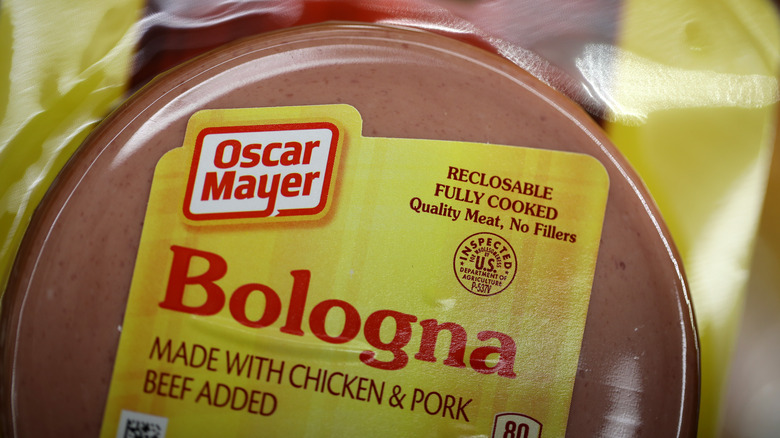Is Bologna Really Just A Bigger Hot Dog?
Americans love cured meat. Just head to the grocery and glance at the deli counter; the options range in many shades and sizes. In the fridge section, you'll find even more beloved foodstuffs like ham, turkey, and bacon. Yet if there's one food that really epitomizes America's love for processed meat, it's the hot dog.
More popular now than ever before, hot dogs not only remain a fixture in culture, but also come with a composition regulated by the U.S. Department of Agriculture. The federal organization oversees the ratios of fat, water, and protein content in the sausage, and forbids ingredients like mechanically separated meat. However, even with such terms, the definition is surprisingly broad. Federal guidelines allow for the interchangeable naming of frankfurters, wieners, and even bologna, categorizing all as the same product.
So essentially, by the terms of the U.S. government, bologna is just a bigger hot dog with a different name. To some, it's a contentious claim: The two foods come from distinct food cultures and are consumed in a different fashion. Yet peer into the details — and their overlapping history — and the answer does become hard to pin down.
The two cured meats emerged from distinct backgrounds
Bologna's history traces further back than the American hot dog, or even the birth of the U.S. itself. It all starts in its namesake city of Bologna, Italy — long an epicurean destination with a rich culinary tradition. Since Roman times, people in the area pulverized pork with a mortar and pestle, then subsequently cured the result. Continually crafted until the present day, the product became known as mortadella.
It's this beloved — and highly esteemed — cold cut that gave rise to bologna. Others took such a recipe of finely-textured pork in a casing and made it their own. This includes German immigrants, who likely brought bologna to the U.S. during the 18th century. A few small differences emerged between bologna and mortadella, namely that mortadella contains cubes of fat, while bologna retains a uniform consistency. Plus, bologna sausage has further evolved into many sub-styles.
Meanwhile, hot dogs came to the U.S. by way of German immigrants. However, such cased sausages instead link to the food traditions of Vienna (birthplace of the wiener) and Frankfurt (origin of frankfurters). This cured meat became popular much later than bologna; it only took off a century later in the 1860s. As a result, the two cured sausages still maintain different regional ties. Hot dog styles reign in cities like Chicago and New York, while bologna's popularity exists in areas like Appalachia, the Midwest, and part of Canada, evincing a distinct history.
Hot dogs and bologna overlap in their mass production
It's undeniable the two cured products share many qualities. After all, both are made of processed minced meat surrounded by casing. By way of their overlapping nomenclature, either can contain slightly different compositions of not only fat and flavoring, but also proteins like turkey, beef, and chicken. In fact, turkey may have been included in some of the earliest American bologna recipes, making it no more of a stretch than a turkey hot dog. So judging exclusively by the ingredient list, it only comes down to how you slice it.
Not to mention the two share a similarly nostalgic place in American culture. The bologna sandwich became a lunchtime favorite by way of affordability, and ease-of-preparation — much like the casual delight of a hot dog. Partly, this can be accredited to German-born Oscar Mayer. In addition to being a colorful part of hot dog history, his company introduced bologna to the American masses. Propelled by innovations like vacuum-sealed packaging as well as successful marketing, the same distributor found nationwide success with both meats. With such similarities, the foods became strongly intertwined — perhaps the reason for the federal regulation. And while bologna dropped-off in popularity at the end of the 20th century, the hot dog remains king; cementing it as the overarching categorization.


